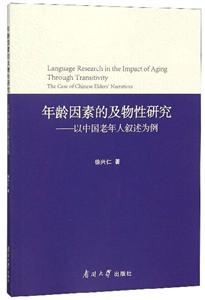掃一掃
關注中圖網
官方微博
本類五星書更多>
-
>
妙相梵容
-
>
基立爾蒙文:蒙文
-
>
我的石頭記
-
>
心靈元氣社
-
>
女性生存戰爭
-
>
縣中的孩子 中國縣域教育生態
-
>
(精)人類的明天(八品)
年齡因素的及物性研究:以中國老年人敘述為例:the case of Chinese elders narratives 版權信息
- ISBN:9787310056989
- 條形碼:9787310056989 ; 978-7-310-05698-9
- 裝幀:一般膠版紙
- 冊數:暫無
- 重量:暫無
- 所屬分類:>>
年齡因素的及物性研究:以中國老年人敘述為例:the case of Chinese elders narratives 內容簡介
《年齡因素的及物性研究:以中國老年人敘述為例(英文版)》系作者徐興仁在美國賓夕法尼亞州立大學應用語言學系攻讀博士學位時期的畢業論文,后在該論文的基礎上精心修改而成。作者應用及物性探索年齡因素對語言能力的影響,提出了一種應用系統功能語言學研究中國老年人敘事能力的新方法,并提出了新的結論,反映了該領域研究的新成果。
年齡因素的及物性研究:以中國老年人敘述為例:the case of Chinese elders narratives 目錄
Chapter 1 INTRODUCTION
1.1 Background
1.2 Chinese Aging and the Gap in its Research
1.2.1 The Problem of the Elders in China
1.2.2 Language-related Chinese Aging Research and its Gap
1.3 The Significance of the Present Study
1.4 Goals of the Present Study
1.5 Brief Descriptions about the Present Research
1.6
Chapter Overview
Chapter 2 LITERATURE REVIEW
2.1 Picture-elicited Narratives
2.2 Previous Research in Aging Using Picture-elicited Narratives
2.3 The Previous Research Using the Insights of Transitivity in SFT
2.4 The Relation of the Present Research with the Previous Research
Chapter 3 THEORETICAL FRAMEWORK
3.1 A Brief Introduction to SFT
3.1.1 A Brief Introduction to Halliday's SFT
3.1.2 The Difference between Halliday and Martin
3.1.3 The Difference between Berry and Halliday
3.1.4 The Overlap between Halliday, Vygotsky and Bemstein.
3.2 Transitivity
3.2.1 The Position of Transitivity in SFT
3.2.2 The Development of Transitivity
3.2.3 The Content of Transitivity
3.2.4 The Difference between Halliday's Transitivity and the Traditional Transitivity
3.2.5 Transitivity——the Intersection of SFT and Other Schools of Linguistics
3.2.6 Transitivity in Neurological and Health Science Research
3.3 Chinese and Transitivity
3.3.1 The Compatibility of Transitivity for Studying Chinese
3.3.2 Chinese Scholars' Research in Transitivity
Chapter 4 METHODOLOGY
4.1 Hypotheses
4.2 Data Collection
4.3 Rationale for Using Secondary Chinese Data
4.4 Participants
4.5 Instrument
4.6 Purpose of Analyzing the Pic~tre-elicited Narrative
4.7 Coding System
4.8 Post-explanation
Chapter 5 ANALYSIS
5.1 Coding
5.2 Coder Training
5.3 Raters Accuracy and Reliability
5.4 Transitivity
5.5 Analysis
5.6 Analyses with Extracts
Chapter 6 RESULTS
6.1 Statistical Solution
6.2 Impact of Age, Education and Gender on the Participants' Overall Performance of Transitivity
6.3 Impact of Age, Education and Gender on Material Process
6.4 Impact of Age, Education and Gender Impact on Mental Process
6.5 Impact of Age, Education and Gender on Verbal Process Performances
6.6 Impact of Age, Education and Gender on Behavioral Process Performance
6.7 Impact of Age, Education and Gender on Relational Process
6.8 Impact of Age, Education and Gender on Existential Process Performance
6.9 Summary of Age, Education and Gender Impact on Transitivity
Chapter 7 CONCLUSION
7.1 Summary of the Objectives, Results and Analysis
7.2 Strengths of the Present Research
7.2.1 Transitivity as a Proper Framework for an Aging Study
7.2.2 Justification of Paradis' Stimuli and Development of Coding System
7.2.3 Proper Use of GLM to Determine Significant Impact
7.3 Limitations
7.3.1 Absence of Post-reflective Comment
7.3.2 Quasi-Longitudinal Study and No True Longitudinal Study
7.3.3 No Requirement for Processing Speed
7.4 Recommendations for Future Research
7.4.1 Extension of Age-span
7.4.2 The Comparison of Normal Elders with Elderly Patients
7.4.3 Mini-lingual Status Examination
7.4.4 Semi-computerized Coding
7.5 Final Remarks
REFERENCES
Appendix
Appendix A: Coding Sheet*
Appendix B: Examples of Empty "be" Relational Process in Chinese
Appendix C: Abbreviations
1.1 Background
1.2 Chinese Aging and the Gap in its Research
1.2.1 The Problem of the Elders in China
1.2.2 Language-related Chinese Aging Research and its Gap
1.3 The Significance of the Present Study
1.4 Goals of the Present Study
1.5 Brief Descriptions about the Present Research
1.6
Chapter Overview
Chapter 2 LITERATURE REVIEW
2.1 Picture-elicited Narratives
2.2 Previous Research in Aging Using Picture-elicited Narratives
2.3 The Previous Research Using the Insights of Transitivity in SFT
2.4 The Relation of the Present Research with the Previous Research
Chapter 3 THEORETICAL FRAMEWORK
3.1 A Brief Introduction to SFT
3.1.1 A Brief Introduction to Halliday's SFT
3.1.2 The Difference between Halliday and Martin
3.1.3 The Difference between Berry and Halliday
3.1.4 The Overlap between Halliday, Vygotsky and Bemstein.
3.2 Transitivity
3.2.1 The Position of Transitivity in SFT
3.2.2 The Development of Transitivity
3.2.3 The Content of Transitivity
3.2.4 The Difference between Halliday's Transitivity and the Traditional Transitivity
3.2.5 Transitivity——the Intersection of SFT and Other Schools of Linguistics
3.2.6 Transitivity in Neurological and Health Science Research
3.3 Chinese and Transitivity
3.3.1 The Compatibility of Transitivity for Studying Chinese
3.3.2 Chinese Scholars' Research in Transitivity
Chapter 4 METHODOLOGY
4.1 Hypotheses
4.2 Data Collection
4.3 Rationale for Using Secondary Chinese Data
4.4 Participants
4.5 Instrument
4.6 Purpose of Analyzing the Pic~tre-elicited Narrative
4.7 Coding System
4.8 Post-explanation
Chapter 5 ANALYSIS
5.1 Coding
5.2 Coder Training
5.3 Raters Accuracy and Reliability
5.4 Transitivity
5.5 Analysis
5.6 Analyses with Extracts
Chapter 6 RESULTS
6.1 Statistical Solution
6.2 Impact of Age, Education and Gender on the Participants' Overall Performance of Transitivity
6.3 Impact of Age, Education and Gender on Material Process
6.4 Impact of Age, Education and Gender Impact on Mental Process
6.5 Impact of Age, Education and Gender on Verbal Process Performances
6.6 Impact of Age, Education and Gender on Behavioral Process Performance
6.7 Impact of Age, Education and Gender on Relational Process
6.8 Impact of Age, Education and Gender on Existential Process Performance
6.9 Summary of Age, Education and Gender Impact on Transitivity
Chapter 7 CONCLUSION
7.1 Summary of the Objectives, Results and Analysis
7.2 Strengths of the Present Research
7.2.1 Transitivity as a Proper Framework for an Aging Study
7.2.2 Justification of Paradis' Stimuli and Development of Coding System
7.2.3 Proper Use of GLM to Determine Significant Impact
7.3 Limitations
7.3.1 Absence of Post-reflective Comment
7.3.2 Quasi-Longitudinal Study and No True Longitudinal Study
7.3.3 No Requirement for Processing Speed
7.4 Recommendations for Future Research
7.4.1 Extension of Age-span
7.4.2 The Comparison of Normal Elders with Elderly Patients
7.4.3 Mini-lingual Status Examination
7.4.4 Semi-computerized Coding
7.5 Final Remarks
REFERENCES
Appendix
Appendix A: Coding Sheet*
Appendix B: Examples of Empty "be" Relational Process in Chinese
Appendix C: Abbreviations
展開全部
書友推薦
- >
名家帶你讀魯迅:故事新編
- >
企鵝口袋書系列·偉大的思想20:論自然選擇(英漢雙語)
- >
【精裝繪本】畫給孩子的中國神話
- >
唐代進士錄
- >
有舍有得是人生
- >
朝聞道
- >
苦雨齋序跋文-周作人自編集
- >
我與地壇
本類暢銷

















